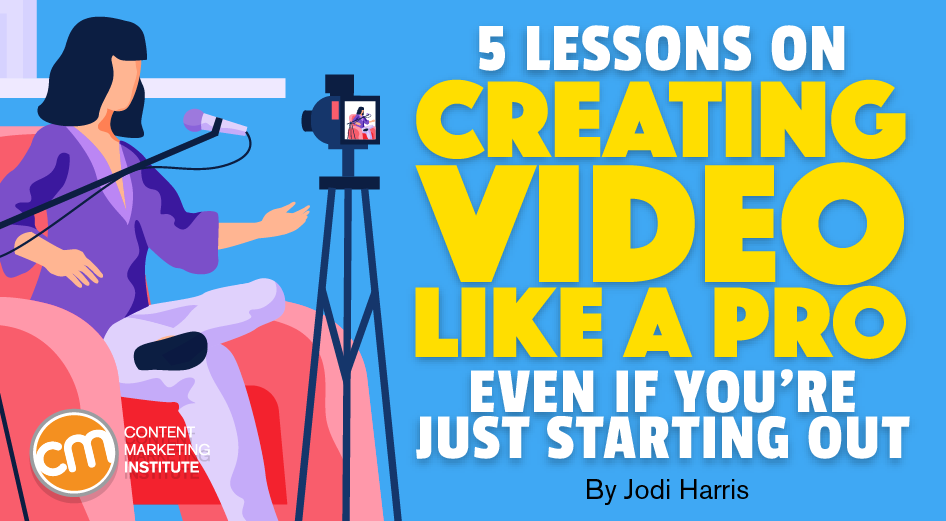MARKETING
5 Lessons on Creating Video Like a Pro

If getting better at working with video is on your content marketing to-do list for this year, you’re in good company. CMI’s most recent Video and Visual Storytelling Research finds 88% of marketers use videos for content marketing, and 60% anticipate spending more on video this year than they did a year ago. Yet, nearly half indicate they weren’t using video to its full potential (48%).
What’s holding them back? Concerns about budget, lack of in-house technical skills, and limited management support sit at the top of the barriers. Once you clear those operational hurdles, there’s still the matter of how to plan, position, and promote your video stories to achieve optimal marketing performance.
In a recent Ask the CMWorld Community chat, Andrew Davis, best-selling author and internationally acclaimed speaker, shared the expertise acquired throughout his career, which spans the entertainment, marketing, and media industries.
Andrew believes with the right upfront preparation, attention to a few critical details, and some expert tips, any business can deliver high-quality, highly engaging video stories – no matter how much or little they invest in developing it.
The right preparation, attention to critical details, and adherence to some expert tips can deliver highly engaging #video stories, says @DrewDavisHere via @joderama @CMIContent. Click To Tweet
Watch the video below for the full conversation, and then read on for some expert tips and shortcuts to streamline your technical processes, sharpen your creative focus, and improve the marketing results from your video content.
Lesson 1: Make sure you have a good writer
Unless you livestream, you need a good writer to craft the stories before you film them. A skilled scriptwriter can help ensure the visual imagery aligns with and reinforces the key points.
Andrew points to another reason high-quality writing is instrumental: It can help you set realistic expectations around your technical capabilities, making production more efficient.
A good writer should craft the stories before you film them, says @DrewDavisHere via @joderama @CMIContent. Click To Tweet
He explains the writer’s creative choices set the stage for many filming requirements, such as:
- Equipment – Will you need a wide-angle lens? Will filming with your phone be an option? Would you need to rent a drone for aerial shots?
- Production work – Will you need someone who can scout locations and handle permit applications?
- Specialized editing skills – Will you need someone with animation experience? Special effects expertise?
An experienced writer also can point to areas that may be challenging to execute (creatively or financially) and come up with viable workarounds. For example, if the initial idea requires aerial camera work or expensive props, the writer can think about ways to script the story to avoid those costly concepts. “Don’t worry about technical stuff until you have a script you’re happy with,” Andrew says.
Lesson 2: Map out your words and images in advance
Like most content marketing assets, videos start as ideas – they likely will get refined, revised, and reworked numerous times before deployment.
Yet, video workflows are more complex than most text-based content. You need to take steps in advance, such as establishing your filming locations and scenery, managing production tasks, such as text overlays, interstitial graphics, and B-roll), and securing technical equipment and expertise, such as editing software and a skilled editor who can turn the raw footage into a cohesive story.
Unlike a blog article or email campaign where you can make small changes and republish almost in an instant, fixing an error or updating a scene in a video can create a ripple effect of time-consuming and costly tasks.
Fixing an error in a #video can create a ripple effect of time-consuming and costly tasks, says @DrewDavisHere via @joderama @CMIContent. Click To Tweet
To avoid those late-game budget busters, Andrew suggests mapping everything – from the copy for the vocal track and the imagery and actions in each scene to the props and anything else your team might need to bring your story to life on video.
Andrew uses a simple, two-column template Word document. He lists each shot he plans to capture. In the left column, he details the audio features, including the spoken script and background sounds or music. On the right, he notes the visual features, including camera angles, B-roll footage, on-camera actions, props, and captions or other effects. He refers to this outline as “a recipe for creating the best possible video for his purpose.”
Here’s what Andrew’s template looks like:
However, if videos are an ongoing focal point of your content marketing, you may invest in a dedicated screenwriting app (like Scrivener or WriterDuet), which provides more scripting templates.
Screenwriting apps such as @ScrivenerApp or @WriterDuet provide more scripting templates, says @DrewDavisHere via @joderama @CMIContent. Click To Tweet
The key is to match up all your audio and video details before filming each shot. As Andrew explains: “When I first started out, I didn’t do this. Then I would realize I didn’t have the shots I needed to make the video really good or that I forgot to say something and would have to reshoot or figure out how to sandwich it in.”
Identifying potential problems and addressing them before committing them to video also prevents editing costs from skyrocketing due to revisions.
Once you have your “recipe” mapped, print and share it with both on-camera talent and video editors, Andrew says. It gives everyone the clarity they need before it’s time for them to do their work, which will make for a better product.
TIP: Do a little online research to learn standard film terminology – like B-roll (background footage), transitions (elements that create smooth segues between scenes), and SFX (sound effects). Use that lingo in your script. “If you can learn the shorthand, you’ll get much more efficient at communicating your vision to your editors,” Andrew says.
ADVERTISEMENT
Report: The Neuroscience of Digital Content
Your buyers are using digital content to discover, understand, and narrow their options before they make a buying decision. But what makes content memorable?! Download the report.
Lesson 3: Gear up for the gig
Filming on the fly using your phone camera might be sufficient for livestreaming or publishing spontaneous conversations. However, this isn’t ideal for producing more detailed or polished stories.
For a higher-quality standard, use specialized filming equipment. Andrew stresses that investing in the right gear is more important than investing in the best gear – especially when you’re starting out.
Investing in the right gear is more important than investing in the best gear, especially when you’re starting out, says @DrewDavisHere via @joderama @CMIContent. #Video Click To Tweet
Though some video tech will be determined by whether you record solo or with a team, Andrew recommends everybody have these tools (in addition to a camera) available when recording:
- Prompter and stand: You can use an iPad or other tablet to display your script. Use a stand to hold it steady and at eye level so your talent can see it clearly. If no one can scroll the script for the on-camera person, get a small Bluetooth connection remote control device that can be hidden in your hand.
- Headphones: Earbuds – the kind you might use for a Zoom call – work great for this, as they’ll block out some of the background noise that might distract you without making it obvious you’re wearing them.
- Tripod: Like your prompter stand, a tripod ensures your camera is steady during still shots and can swivel smoothly when the subject moves. It can prevent bouncy or jarring motions that interfere with the viewing experience.
- Wireless microphone. Your camera might have an internal microphone, but if you’re filming outside a controlled studio environment, you want to minimize background noise and make sure the voices are as clear as possible. The best bet is a small lavalier mic that can clip to the subject’s collar.
- External camera monitor. To see what the camera sees, use a monitor. You can make sure you aren’t moving outside the shot or wasting battery life on some clown who walks by and decides they want to insert themselves into your scene. Though your camera might have a flip-down screen for this purpose, a large, battery-operated monitor that attaches to the camera will make your life easier.
- Cords and extra batteries – for all your gear. You never want to get to your filming location and realize you forgot an essential cable or dongle or discover a dead battery with no way to recharge it.
Lesson 4: Check yourself before you wreck your video
Dead batteries aren’t the only thing that can ruin your filming plans. In fact, Andrew says you need to check a lot of small but important details before the cameras roll. “I cannot tell you how many times I have realized after filming, like, for 20 minutes that the microphone is not working or that I’m out of focus,” he says.
Time is money on a video shoot. So, while a seasoned pro like Andrew has developed a mental checklist, he runs through as he sets up each new shot, he suggests having a written reference when you’re starting out.
If you’re filming at an in-home or -office studio, Andrew offers a few more questions for the checklist:
- Did you close the doors to the room in which you’re recording?
- Did you yell, “Quiet on the set,” so everyone in the house/studio knows you’re recording?
- Did you notify people who may enter the building after the recording starts by text or sign about the video production?
- Did you remember to silence your phone (and any other devices in the room)?
- Did you crank the air conditioning? Between the lights and nerves, things can really heat up when you’re on camera. You won’t want to make everyone stop in the middle of a scene so you can wipe off your sweat or turn the thermostat down a few degrees.
- Did you yell, “That’s a wrap,” so everyone knows they can go back to normal?
Lesson 5: Make strategic, data-driven creative choices
Andrew estimates he and his team put in about 40 hours to create a video. That might seem like a lot of time, especially in an era where livestream videos can go from idea to on-air in minutes.
Most of those spots run between 30 seconds and six minutes. Andrew’s videos typically run between seven and 10 minutes. Why doesn’t he produce shorter pieces? It’s all about his strategic goals. Andrew says:
The real core of my audience doesn’t want a superficial marketing tip and trick because they can get a million of those elsewhere online. I’m trying to help people think strategically about the marketing they’re doing and how to deliver a better customer experience. To me, that [requires lengthier videos]. I think it also helps to take people on a real journey.
Andrew doesn’t take his creative cues from industry standards, assumptions, or rules of thumb about audience content preferences. Rather, he creates videos based on what his audience tells him resonates directly or through metrics. Here are a few ways he gathers that feedback:
- Audience retention rates: He compares the retention rates for each video on his YouTube channel. For example, one popular video showed a retention rate of 50% – meaning half of those who viewed the video watched until its completion. For videos that don’t reach that retention rate, he does a deeper dive into their creative and technical details, such as length, topic, title, and tags, to learn what might not have worked as well.
- Subscriber responses: Andrew includes links to his videos in Loyalty Loop, a weekly email newsletter. He tracks direct replies to those emails: “Lots of people click, open, and watch it, but the people who respond – especially when it’s about something that really hit a chord – help me understand what’s working because it tells me what they’re liking, what’s challenging them, and what are they learning,” he says.
- Comments: Andrew also mines the comments viewers leave on the YouTube page and below his LinkedIn posts where he shares the link.
Create winning videos – without losing your mind
A little extra efficiency in your video creation processes can add up to big marketing gains – in content quality, audience engagement, and video performance. Follow Andrew’s pro tips and let us know how it goes. If you have some video planning and preparation tips to share, why not pop them into the comments below?
All tools are identified by the author or sources. Feel free to include additional tools in the comments (from your company or ones that you have used).
Cover image by Joseph Kalinowski/Content Marketing Institute
MARKETING
Tinuiti Marketing Analytics Recognized by Forrester

Rapid Media Mix Modeling and Proprietary Tech Transform Brand Performance
Tinuiti, the largest independent full-funnel performance marketing agency, has been included in a recent Forrester Research report titled, “The Marketing Analytics Landscape, Q2 2024.” This report comprehensively overviews marketing analytics markets, use cases, and capabilities. B2C marketing leaders can use this research by Principal Analyst Tina Moffett to understand the intersection of marketing analytics capabilities and use cases to determine the vendor or service provider best positioned for their analytics and insights needs. Moffett describes the top marketing analytics markets as advertising agencies, marketing dashboards and business intelligence tools, marketing measurement and optimization platforms and service providers, and media analytics tools.
As an advertising agency, we believe Tinuiti is uniquely positioned to manage advertising campaigns for brands including buying, targeting, and measurement. Our proprietary measurement technology, Bliss Point by Tinuiti, allows us to measure the optimal level of investment to maximize impact and efficiency. According to the Forrester report, “only 30% of B2C marketing decision-makers say their organization uses marketing or media mix modeling (MMM),” so having a partner that knows, embraces, and utilizes MMM is important. As Tina astutely explains, data-driven agencies have amplified their marketing analytics competencies with data science expertise; and proprietary tools; and tailored their marketing analytics techniques based on industry, business, and data challenges.
Our Rapid Media Mix Modeling sets a new standard in the market with its exceptional speed, precision, and transparency. Our patented tech includes Rapid Media Mix Modeling, Always-on Incrementality, Brand Equity, Creative Insights, and Forecasting – it will get you to your Marketing Bliss Point in each channel, across your entire media mix, and your overall brand performance.
As a marketing leader you may ask yourself:
- How much of our marketing budget should we allocate to driving store traffic versus e-commerce traffic?
- How should we allocate our budget by channel to generate the most traffic and revenue possible?
- How many customers did we acquire in a specific region with our media spend?
- What is the impact of seasonality on our media mix?
- How should we adjust our budget accordingly?
- What is the optimal marketing channel mix to maximize brand awareness?
These are just a few of the questions that Bliss Point by Tinuiti can help you answer.
Learn more about our customer-obsessed, product-enabled, and fully integrated approach and how we’ve helped fuel full-funnel outcomes for the world’s most digital-forward brands like Poppi & Toms.
The Landscape report is available online to Forrester customers or for purchase here.
MARKETING
Ecommerce evolution: Blurring the lines between B2B and B2C

Understanding convergence
B2B and B2C ecommerce are two distinct models of online selling. B2B ecommerce is between businesses, such as wholesalers, distributors, and manufacturers. B2C ecommerce refers to transactions between businesses like retailers and consumer brands, directly to individual shoppers.
However, in recent years, the boundaries between these two models have started to fade. This is known as the convergence between B2B and B2C ecommerce and how they are becoming more similar and integrated.
Source: White Paper: The evolution of the B2B Consumer Buyer (ClientPoint, Jan 2024)
What’s driving this change?
Ever increasing customer expectations
Customers today expect the same level of convenience, speed, and personalization in their B2B transactions as they do in their B2C interactions. B2B buyers are increasingly influenced by their B2C experiences. They want research, compare, and purchase products online, seamlessly transitioning between devices and channels. They also prefer to research and purchase online, using multiple devices and channels.
Forrester, 68% of buyers prefer to research on their own, online . Customers today expect the same level of convenience, speed, and personalization in their B2B transactions as they do in their B2C interactions. B2B buyers are increasingly influenced by their B2C experiences. They want research, compare, and purchase products online, seamlessly transitioning between devices and channels. They also prefer to research and purchase online, using multiple devices and channels
Technology and omnichannel strategies
Technology enables B2B and B2C ecommerce platforms to offer more features and functionalities, such as mobile optimization, chatbots, AI, and augmented reality. Omnichannel strategies allow B2B and B2C ecommerce businesses to provide a seamless and consistent customer experience across different touchpoints, such as websites, social media, email, and physical stores.
However, with every great leap forward comes its own set of challenges. The convergence of B2B and B2C markets means increased competition. Businesses now not only have to compete with their traditional rivals, but also with new entrants and disruptors from different sectors. For example, Amazon Business, a B2B ecommerce platform, has become a major threat to many B2B ecommerce businesses, as it offers a wide range of products, low prices, and fast delivery
“Amazon Business has proven that B2B ecommerce can leverage popular B2C-like functionality” argues Joe Albrecht, CEO / Managing Partner, Xngage. . With features like Subscribe-and-Save (auto-replenishment), one-click buying, and curated assortments by job role or work location, they make it easy for B2B buyers to go to their website and never leave. Plus, with exceptional customer service and promotional incentives like Amazon Business Prime Days, they have created a reinforcing loyalty loop.
And yet, according to Barron’s, Amazon Business is only expected to capture 1.5% of the $5.7 Trillion addressable business market by 2025. If other B2B companies can truly become digital-first organizations, they can compete and win in this fragmented space, too.”
If other B2B companies can truly become digital-first organizations, they can also compete and win in this fragmented space
Joe AlbrechtCEO/Managing Partner, XNGAGE
Increasing complexity
Another challenge is the increased complexity and cost of managing a converging ecommerce business. Businesses have to deal with different customer segments, requirements, and expectations, which may require different strategies, processes, and systems. For instance, B2B ecommerce businesses may have to handle more complex transactions, such as bulk orders, contract negotiations, and invoicing, while B2C ecommerce businesses may have to handle more customer service, returns, and loyalty programs. Moreover, B2B and B2C ecommerce businesses must invest in technology and infrastructure to support their convergence efforts, which may increase their operational and maintenance costs.
How to win
Here are a few ways companies can get ahead of the game:
Adopt B2C-like features in B2B platforms
User-friendly design, easy navigation, product reviews, personalization, recommendations, and ratings can help B2B ecommerce businesses to attract and retain more customers, as well as to increase their conversion and retention rates.
According to McKinsey, ecommerce businesses that offer B2C-like features like personalization can increase their revenues by 15% and reduce their costs by 20%. You can do this through personalization of your website with tools like Product Recommendations that help suggest related products to increase sales.
Focus on personalization and customer experience
B2B and B2C ecommerce businesses need to understand their customers’ needs, preferences, and behaviors, and tailor their offerings and interactions accordingly. Personalization and customer experience can help B2B and B2C ecommerce businesses to increase customer satisfaction, loyalty, and advocacy, as well as to improve their brand reputation and competitive advantage. According to a Salesforce report, 88% of customers say that the experience a company provides is as important as its products or services.
Market based on customer insights
Data and analytics can help B2B and B2C ecommerce businesses to gain insights into their customers, markets, competitors, and performance, and to optimize their strategies and operations accordingly. Data and analytics can also help B2B and B2C ecommerce businesses to identify new opportunities, trends, and innovations, and to anticipate and respond to customer needs and expectations. According to McKinsey, data-driven organizations are 23 times more likely to acquire customers, six times more likely to retain customers, and 19 times more likely to be profitable.
What’s next?
The convergence of B2B and B2C ecommerce is not a temporary phenomenon, but a long-term trend that will continue to shape the future of ecommerce. According to Statista, the global B2B ecommerce market is expected to reach $20.9 trillion by 2027, surpassing the B2C ecommerce market, which is expected to reach $10.5 trillion by 2027. Moreover, the report predicts that the convergence of B2B and B2C ecommerce will create new business models, such as B2B2C, B2A (business to anyone), and C2B (consumer to business).
Therefore, B2B and B2C ecommerce businesses need to prepare for the converging ecommerce landscape and take advantage of the opportunities and challenges it presents. Here are some recommendations for B2B and B2C ecommerce businesses to navigate the converging landscape:
- Conduct a thorough analysis of your customers, competitors, and market, and identify the gaps and opportunities for convergence.
- Develop a clear vision and strategy for convergence, and align your goals, objectives, and metrics with it.
- Invest in technology and infrastructure that can support your convergence efforts, such as cloud, mobile, AI, and omnichannel platforms.
- Implement B2C-like features in your B2B platforms, and vice versa, to enhance your customer experience and satisfaction.
- Personalize your offerings and interactions with your customers, and provide them with relevant and valuable content and solutions.
- Leverage data and analytics to optimize your performance and decision making, and to innovate and differentiate your business.
- Collaborate and partner with other B2B and B2C ecommerce businesses, as well as with other stakeholders, such as suppliers, distributors, and customers, to create value and synergy.
- Monitor and evaluate your convergence efforts, and adapt and improve them as needed.
By following these recommendations, B2B and B2C ecommerce businesses can bridge the gap between their models and create a more integrated and seamless ecommerce experience for their customers and themselves.
MARKETING
Streamlining Processes for Increased Efficiency and Results

How can businesses succeed nowadays when technology rules? With competition getting tougher and customers changing their preferences often, it’s a challenge. But using marketing automation can help make things easier and get better results. And in the future, it’s going to be even more important for all kinds of businesses.
So, let’s discuss how businesses can leverage marketing automation to stay ahead and thrive.
Benefits of automation marketing automation to boost your efforts
First, let’s explore the benefits of marketing automation to supercharge your efforts:
Marketing automation simplifies repetitive tasks, saving time and effort.
With automated workflows, processes become more efficient, leading to better productivity. For instance, automation not only streamlines tasks like email campaigns but also optimizes website speed, ensuring a seamless user experience. A faster website not only enhances customer satisfaction but also positively impacts search engine rankings, driving more organic traffic and ultimately boosting conversions.
Automation allows for precise targeting, reaching the right audience with personalized messages.
With automated workflows, processes become more efficient, leading to better productivity. A great example of automated workflow is Pipedrive & WhatsApp Integration in which an automated welcome message pops up on their WhatsApp
within seconds once a potential customer expresses interest in your business.
Increases ROI
By optimizing campaigns and reducing manual labor, automation can significantly improve return on investment.
Leveraging automation enables businesses to scale their marketing efforts effectively, driving growth and success. Additionally, incorporating lead scoring into automated marketing processes can streamline the identification of high-potential prospects, further optimizing resource allocation and maximizing conversion rates.
Harnessing the power of marketing automation can revolutionize your marketing strategy, leading to increased efficiency, higher returns, and sustainable growth in today’s competitive market. So, why wait? Start automating your marketing efforts today and propel your business to new heights, moreover if you have just learned ways on how to create an online business
How marketing automation can simplify operations and increase efficiency
Understanding the Change
Marketing automation has evolved significantly over time, from basic email marketing campaigns to sophisticated platforms that can manage entire marketing strategies. This progress has been fueled by advances in technology, particularly artificial intelligence (AI) and machine learning, making automation smarter and more adaptable.
One of the main reasons for this shift is the vast amount of data available to marketers today. From understanding customer demographics to analyzing behavior, the sheer volume of data is staggering. Marketing automation platforms use this data to create highly personalized and targeted campaigns, allowing businesses to connect with their audience on a deeper level.
The Emergence of AI-Powered Automation
In the future, AI-powered automation will play an even bigger role in marketing strategies. AI algorithms can analyze huge amounts of data in real-time, helping marketers identify trends, predict consumer behavior, and optimize campaigns as they go. This agility and responsiveness are crucial in today’s fast-moving digital world, where opportunities come and go in the blink of an eye. For example, we’re witnessing the rise of AI-based tools from AI website builders, to AI logo generators and even more, showing that we’re competing with time and efficiency.
Combining AI-powered automation with WordPress management services streamlines marketing efforts, enabling quick adaptation to changing trends and efficient management of online presence.
Moreover, AI can take care of routine tasks like content creation, scheduling, and testing, giving marketers more time to focus on strategic activities. By automating these repetitive tasks, businesses can work more efficiently, leading to better outcomes. AI can create social media ads tailored to specific demographics and preferences, ensuring that the content resonates with the target audience. With the help of an AI ad maker tool, businesses can efficiently produce high-quality advertisements that drive engagement and conversions across various social media platforms.
Personalization on a Large Scale
Personalization has always been important in marketing, and automation is making it possible on a larger scale. By using AI and machine learning, marketers can create tailored experiences for each customer based on their preferences, behaviors, and past interactions with the brand.
This level of personalization not only boosts customer satisfaction but also increases engagement and loyalty. When consumers feel understood and valued, they are more likely to become loyal customers and brand advocates. As automation technology continues to evolve, we can expect personalization to become even more advanced, enabling businesses to forge deeper connections with their audience. As your company has tiny homes for sale California, personalized experiences will ensure each customer finds their perfect fit, fostering lasting connections.
Integration Across Channels
Another trend shaping the future of marketing automation is the integration of multiple channels into a cohesive strategy. Today’s consumers interact with brands across various touchpoints, from social media and email to websites and mobile apps. Marketing automation platforms that can seamlessly integrate these channels and deliver consistent messaging will have a competitive edge. When creating a comparison website it’s important to ensure that the platform effectively aggregates data from diverse sources and presents it in a user-friendly manner, empowering consumers to make informed decisions.
Omni-channel integration not only betters the customer experience but also provides marketers with a comprehensive view of the customer journey. By tracking interactions across channels, businesses can gain valuable insights into how consumers engage with their brand, allowing them to refine their marketing strategies for maximum impact. Lastly, integrating SEO services into omni-channel strategies boosts visibility and helps businesses better understand and engage with their customers across different platforms.
The Human Element
While automation offers many benefits, it’s crucial not to overlook the human aspect of marketing. Despite advances in AI and machine learning, there are still elements of marketing that require human creativity, empathy, and strategic thinking.
Successful marketing automation strikes a balance between technology and human expertise. By using automation to handle routine tasks and data analysis, marketers can focus on what they do best – storytelling, building relationships, and driving innovation.
Conclusion
The future of marketing automation looks promising, offering improved efficiency and results for businesses of all sizes.
As AI continues to advance and consumer expectations change, automation will play an increasingly vital role in keeping businesses competitive.
By embracing automation technologies, marketers can simplify processes, deliver more personalized experiences, and ultimately, achieve their business goals more effectively than ever before.
-

 SEARCHENGINES6 days ago
SEARCHENGINES6 days agoGoogle Core Update Volatility, Helpful Content Update Gone, Dangerous Google Search Results & Google Ads Confusion
-

 SEO6 days ago
SEO6 days ago10 Paid Search & PPC Planning Best Practices
-

 MARKETING5 days ago
MARKETING5 days ago5 Psychological Tactics to Write Better Emails
-

 MARKETING7 days ago
MARKETING7 days ago2 Ways to Take Back the Power in Your Business: Part 2
-

 SEARCHENGINES5 days ago
SEARCHENGINES5 days agoWeekend Google Core Ranking Volatility
-

 SEO6 days ago
SEO6 days agoWordPress Releases A Performance Plugin For “Near-Instant Load Times”
-

 MARKETING6 days ago
MARKETING6 days agoThe power of program management in martech
-
SEARCHENGINES4 days ago
Daily Search Forum Recap: April 15, 2024

















You must be logged in to post a comment Login